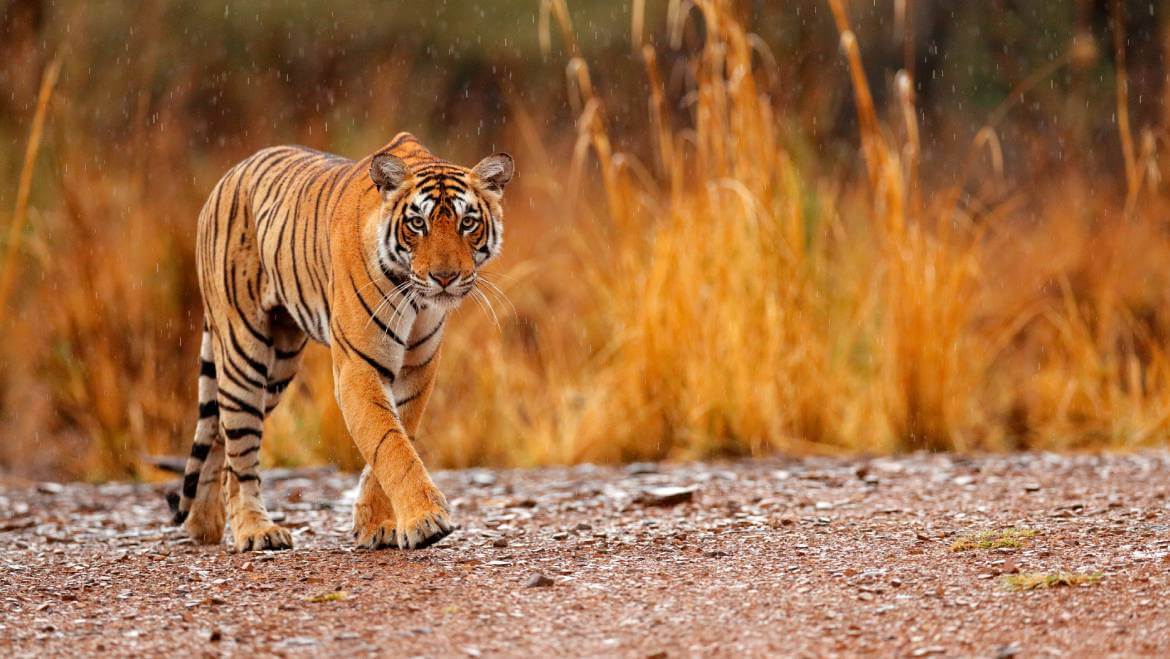India today is home to 70 percent of the world’s population of the Bengal tigers as per a recent report published by the National Tiger Conservation Authority, the authority responsible for mandating and supervising tiger conservation practices in the country. Even though today India is home to around 3,167 tigers, it wasn’t always the case. Barbarous practices of hunting for game, and poaching for trade and other purposes led to a severe decline in the population of the big cats in the country, which was showcased in a survey conducted in 1972. Consequently in 1973, Project Tiger was launched to conserve the existing tigers and protect them from going extinct.
Now, fifty years since its implementation, Project Tiger has seen much progress, with the country’s reserve seeing a 6 percent increase in the number of tigers annually on an average. With such an abundance of tigers in India, it has become increasingly easier to spot the big cat. Spread throughout the country, India has as many as 54 tiger reserves that serve as some of the best places for tiger spotting.
We understand that with such a plethora of options to choose from, it can be difficult to decide where to begin your search, and so we bring to you a list of 6 of the most popular tiger reserves in India with the best forest reserves where spotting a tiger in its habitat need not be tiresome. With patience, luck, and planning, you can most certainly experience being close to the big cat.
Explore Popular Tour Packages for Amazing Tiger Jungle Safaris in India
Bandhavgarh Tiger Reserve, Madhya Pradesh
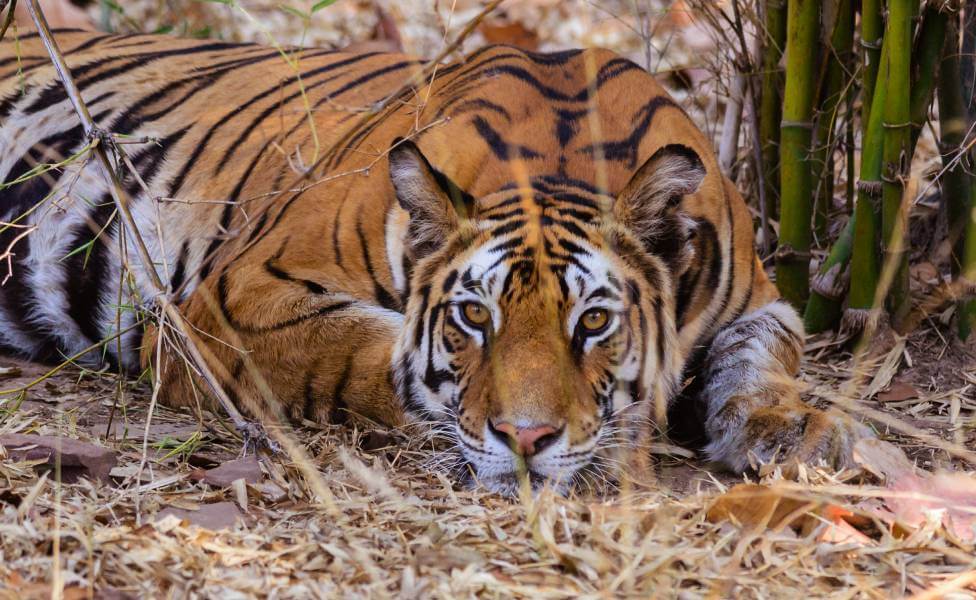
The Bandhavgarh Tiger Reserve is among India’s must visit tiger reserves that it holds with pride. With a total area of 1536.93 sq. km, the reserve is divided into a core area of 716.90 sq. km and a buffer area of 820.03 sq. km. Located in Madhya Pradesh, this tiger reserve is one of the more populated reserves in the country which houses a sizable population of the Bengal Tigers.
Notified as a national park in 1968, Bandhavgarh was included under the Project Tiger as a tiger reserve in 1993. Project Tiger was an initiative launched in 1973 by the then government of India to conserve the remaining population of the Bengal Tigers in the country, which stood depleting due to ravenous practices of hunting and poaching among the country’s forests. Hence, there was an urgent need to save the tigers. To prevent them from becoming an extinct species, Project Tiger came into fruition.
Today, with the efforts of the reserve’s concerned authorities and that of the NTCA, the tiger population at Bandhavgarh has grown to an approximate total of 135 tigers as per the latest report released by the NTCA this year, with Madhya Pradesh containing a total of 785 Bengal tigers, the highest number recorded among the states of the country.
The best way to spot tigers at Bandhavgarh would include going on a jungle safari. On the safari, you might get a chance to sight the Bengal tiger roaming about in its natural habitat, unaware of the prying eyes. Apart from the tigers, other wildlife that can be seen at Bandhavgarh includes leopards, Indian wild dogs, Indian fox, sloth bears, and wild elephants, among many others. Along your safari different species of reptiles and mammals as well can be spotted at the reserve. A bountiful vegetation of dense reserve forests of Sal, Bamboo and grasslands, the Bandhavgarh tiger reserve makes the perfect environment for its apex predator to flourish.
Timings for Jungle Safari at Bandhavgarh
| Date |
Morning safari |
Evening safari |
| 15th Oct to 15th Feb |
06.30 AM – 11.00 AM |
02.30 PM – 05.30 PM |
| 16th Feb to 31st March |
06.00 AM – 11.00 AM |
03.00 PM to 06.00 PM |
| 1st April to 30th June |
05.30 AM – 10.00 AM |
04.00 PM to 07.00 PM |
Note: Bandhavgarh Tiger Reserve remains closed on Wednesday afternoons, so it is advisable to plan your visit to the reserve accordingly.
Ranthambore Tiger Reserve, Rajasthan
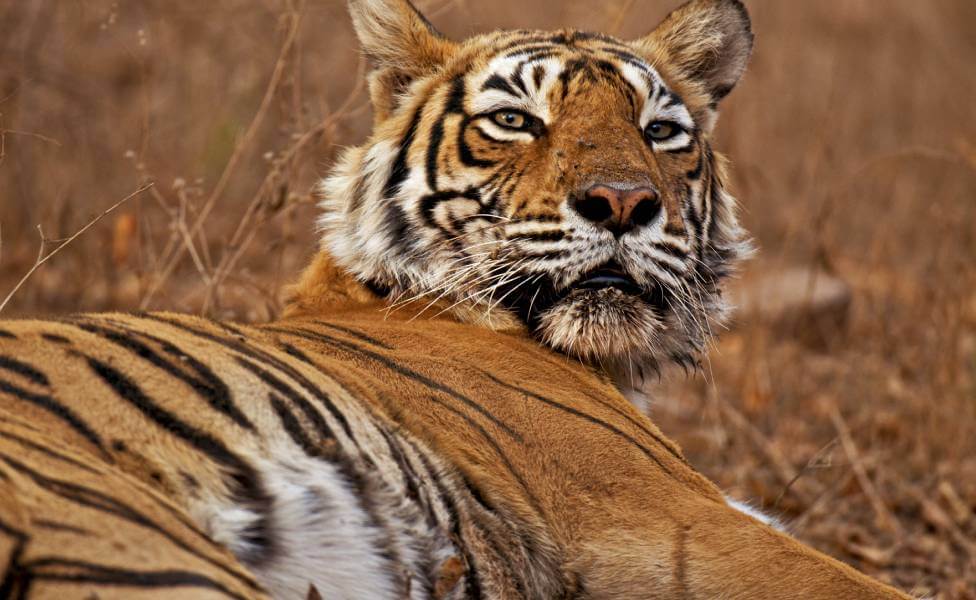
One of the most famous tiger reserves in India, the Tiger Reserve at Ranthambore is home to the Bengal Tiger, one of the big cat species. The Ranthambore Tiger Reserve, located in Sawai Madhopur in the state of Rajasthan was first created as a wildlife sanctuary in 1955 which eventually evolved into one of India’s vital tiger reserves and today, is considered to be one of the country’s larger tiger habitats.
To prevent the remaining forests from disappearing, the state government of Rajasthan passed the Rajasthan Forest Act in 1953. Following that, the Sawai Madhopur Sanctuary was established in 1955, encompassing the forest surrounding Ranthambore. The Indian government launched Project Tiger in 1973 with the goal of conserving and safeguarding the endangered tigers in these reserve forests’. As a result, sections of the sanctuary were designated as Tiger Reserves. Regarding the success of the Project, according to a recent census of the reserve, it was found that the number of Bengal tigers has increased from 66 in 2019 to 81 in 2021.
Take a safari cruising through its jungles if you want to get a closer look at the tigers and watch them in all their glory. In addition to the tigers, the property is home to a variety of species, including birds, reptiles, hyenas, leopards, and wild cats which you can spot on your safari. With its proximity to Rajasthan’s Thar Desert, the Ranthambore National Park features a dry, deciduous forest with little precipitation. The park is home to a wide variety of flowering plant species, with the Dhok tree being the most common, providing food for the park’s many herbivores with its bushes and fruits.
Once functioned as the hunting ground for the royals of Rajasthan, Ranthambore, today works as one of the best forest reserves for the Bengal Tigers in India.
Timings for Jungle Safari at Ranthambore
| Date |
Morning safari |
Evening safari |
| 1st Oct to 31st Oct |
06.30 AM – 10.00 AM |
02.30 PM – 06.00 PM |
| 1st Nov to 31st Jan |
07.00 AM – 10.30 AM |
02.00 PM to 05.30 PM |
| 1st Feb to 31st march |
06.30 AM – 10.00 AM |
02.30 PMto 06.00 PM |
| 1st April to 15th May |
06.00 AM – 09.30 AM |
03.00 PM to 06.30 PM |
| 16th May to 30th June |
06.00 AM – 09.30 AM |
03.30 PM to 07.00 PM |
Note: Ranthambore Tiger Reserve remains closed on Wednesdays, so it is advisable to plan your visit to the reserve accordingly.
Jim Corbett Tiger Reserve, Uttarakhand
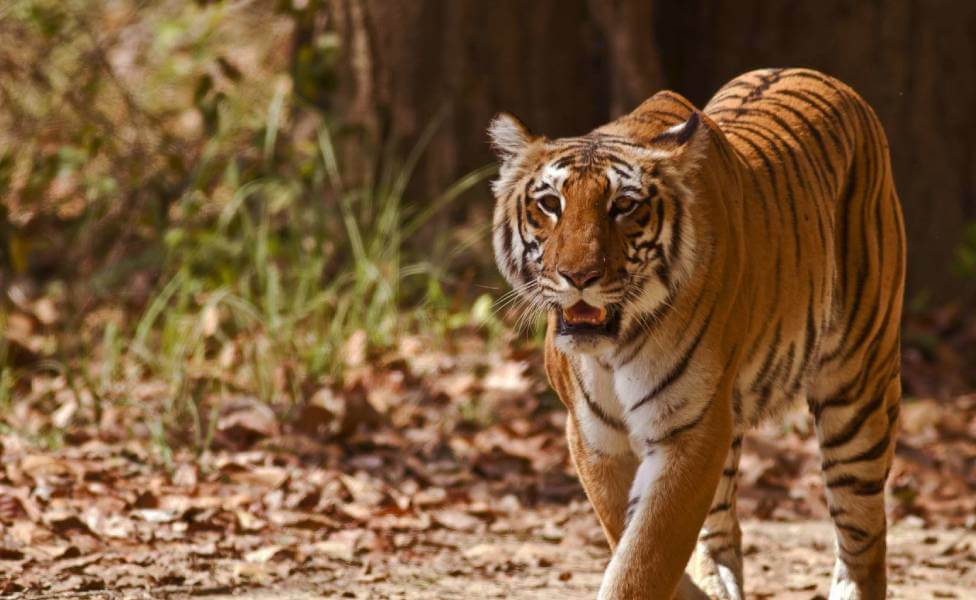
Located in Uttarakhand’s Nainital district, the Jim Corbett National Park was founded as India’s first ever national park and has been regarded as a must visit tiger reserve by its visitors. Named after Jim Corbett in 1956, a famed Indian-born British hunter, it was originally established as Hailey National Park in 1936 with an aim to conserve and protect Uttarakhand’s forests and the wildlife within. At the time, it stood to be the first national park in all of Asia!
Since then, the park has been home to a number of wild animals such as leopards, elephants, deer, and many species of reptiles. Though today, the national park is most prominently known for its population of the Bengal tigers, which are found in abundance throughout the reserve. This increase in their population is attributed to the national park being included as the first one as a tiger reserve under the Project Tiger initiative in 1973.
With a core area of 520 sq. km. and the rest accounted for as the buffer area, the Jim Corbett Tiger Reserve has a total area of 1318 sq. km. The tiger reserve has a diverse landscape and covers various geographical features such as hills, grasslands, riverbanks, streams, waterfalls, and lakes that help in the habitation of the big cats. Jim Corbett’s Tiger Reserve is one of the best places to spot tigers in India, with it being home to the greatest number of tigers among the tiger reserves of the country, with an approximate total of 260 tigers, according to a report released by the NTCA this year.
Jim Corbett Tiger Reserve is not only known for its high number of tigers but also for having the most density of tigers in the world! With a variety of birds, mammals, and reptiles, the tiger reserve acts as an important biodiversity hotspot.
Timings for Jungle Safari at Jim Corbett
| Date |
Morning safari |
Evening safari |
| March to June |
06.00 AM – 09.30 AM |
03.00 PM – 06.30 PM |
| November to February |
07.00 AM – 10.00 AM |
02.00 PM to 05.00 PM |
Kanha Tiger Reserve, Madhya Pradesh
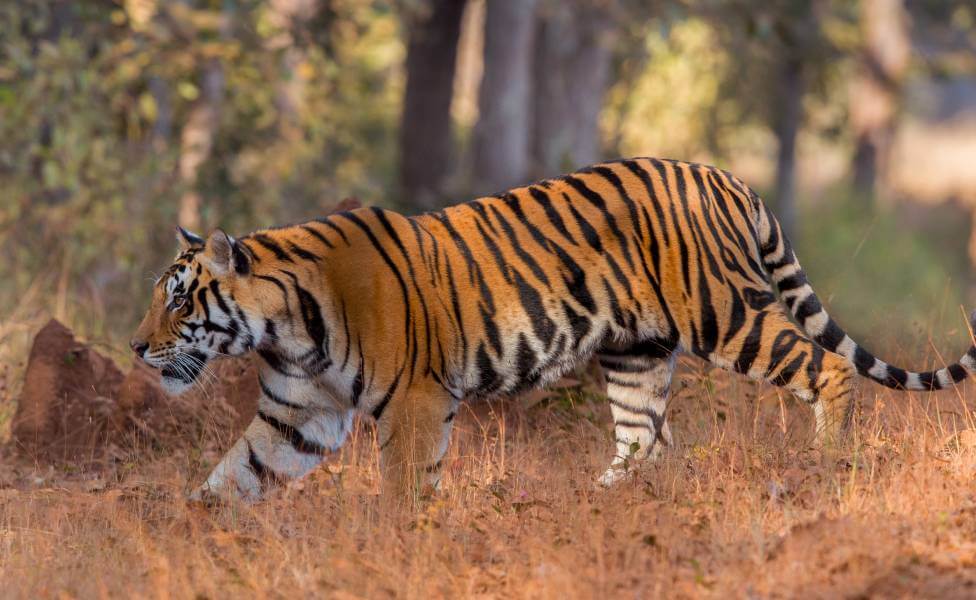
Situated in the hills of the Satpura range, Kanha Tiger Reserve is the biggest national tiger reserve in Madhya Pradesh and is often regarded as the most expertly managed in the country. The park took pride in its occupants, the Royal Bengal tigers, and rose to prominence as one of the nation’s main tiger reserves under Project Tiger in 1973. It wouldn’t be wrong to say that the Kanha National Park was the inspiration for Rudyard Kipling’s ‘The Jungle Book’. Kipling drew his inspiration from the woodlands and their inhabitants, particularly from the Sal forests and for the notorious Sher Khan, making the reserve one of the more popular tiger reserves in India.
The Maikal Range, which forms the eastern base of the Satpura Range, is home to Kanha National Park, which is located in the state of Madhya Pradesh in central India. With a buffer zone of 1134 square kilometers, the park has a total area of 940 square kilometers. The Hallon and Banjar rivers, both tributaries of the Narmada, form the foundation of the park.
Kanha National Park, one of the best places to spot a tiger in India, is well-known for its Bengal Tiger population and its Barasingha, or swamp deer, variety of deer. In addition, the park is home to a variety of other creatures, including Blue Bull, or Nilgai, Indian Wild Dogs, Sloth Bear, Indian Leopard, Gaur, Wild Boar, and the Chital and Sambhar species of deer. For those who enjoy observing birds in the vast forest, Kanha is home to a variety of species, including the Quail, Red and Gray forest Fowl, White-rumped Shama, the majestic Indian Peafowl, and other varieties of Eagles and Vultures.
If one is willing, Kanha even provides an exhilarating safari adventure in the bush. This is your chance to get up close and personal with the majestic Bengal tigers, the Barasingha Deer, leopards, wild canines, and a variety of other animals and birds! Kanha National Park is a wonderful example of how planning and persistence can yield rewards.
Kanha’s forests are home to around 70 different species of trees and more than 200 species of blooming plants. The trees in the forests are a mix of moist and dry deciduous varieties. Kanha National Park is home to several notable trees, including the magnificent Sal, Bamboo, Teak, Shisham, Saja, and Bija. Meadows, different climbers, herbs, and shrubs can be found throughout the park. The park’s herbivorous species, such antelope and deer, depend on these floras to survive, which in turn supports the food chain.
Home to another endangered species, the Barasingha or the Swamp Deer, Kanha National Park has managed to be a safe haven for the species and prevented their extinction. The park is a perfect spot for the ones who love adventure and aren’t afraid to witness a tiger in its natural habitat.
Timings for Jungle Safari at Kanha
| Dates |
Morning Safari |
Evening Safari |
| 15th Oct to 15th Feb |
Sunrise to 11:00 AM |
02:00 PM to Sunset |
| 16th Feb to 15th April |
Sunrise to 11:00 AM |
03:00 PM to Sunset |
| 16th April to 30th June |
Sunrise to 10:00 AM |
03:30 PM to Sunset |
Tadoba Andhari Tiger Reserve, Maharashtra
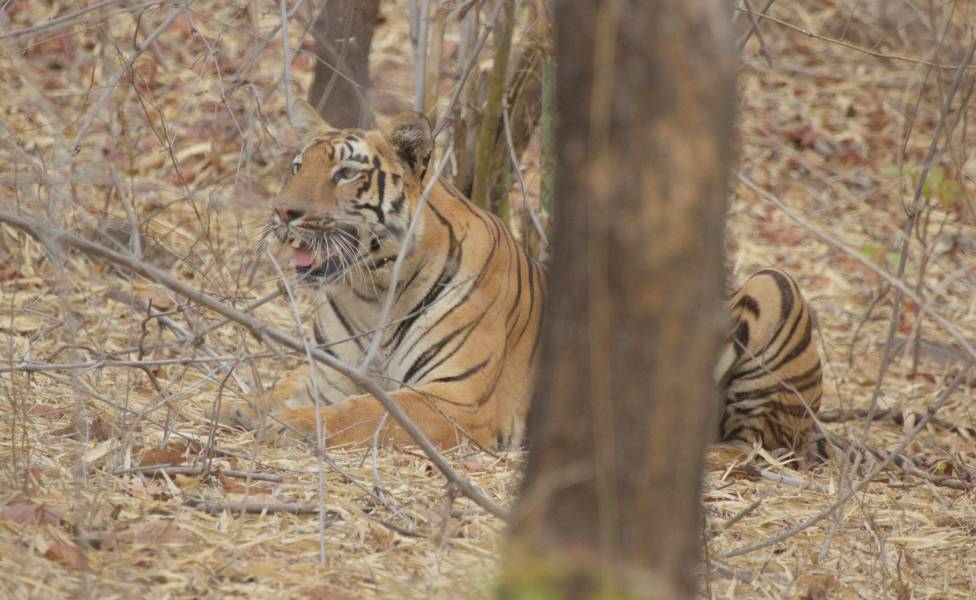
One of India’s best tiger reserves in India is the Tadoba – Andhari Tiger Reserve, which is situated in the Maharashtra district of Chandrapur. The tiger population in this reserve in India is reportedly rising the fastest. At least 80 tigers live in the area’s tropical dry deciduous forest, with the total number of tigers in the surrounding area exceeding 200, making it one of the best forest reserves in India to spot tigers. Other carnivore species found in Tadoba include the leopard and dhole, with the most prevalent prey species being the sambar, chital, wild pig, and gaur.
Tadoba Andhari Tiger Reserve gets its name from a legend surrounding the area, about a village headman that belonged to the Gond Tribe of the region. He is said to have fought a tiger near his village. In different versions of the story, the man, named Taru, either emerges victorious after defeating the tiger or gets slain in another one. Whatever the truth may be, he is highly revered among the tribe, and is the reason for the surrounding forest and lake, and later the reserve being named so, lending Taru to Tadoba.
It was later in 1879, under the British Raj that the forest of Tadoba was declared as a reserve forest with a primary aim to protect the timber trees, followed by restrictions on shooting of all animals by 1931, which led to the conservation of the wildlife within the forest.
It was then in 1955, that Tadoba was declared as a national park with the surrounding area of the forest land declared as the Andhari Wildlife Sanctuary. The national park and the wildlife sanctuary were finally merged in 1993 when Tadoba-Andhari Tiger Reserve (TATR), spanning 622.87 sq km, was established.
Timings for Jungle Safari at Tadoba – Andhari
| Dates |
Morning Safari |
Evening Safari |
| 1st Oct to 30th Nov |
06.00 AM – 08.00 AM |
02.30 PM – 04.00 PM |
| 1st Dec to 28th/29th Feb |
06.30 AM – 08.30 AM |
02.00 PM – 03.30 PM |
| 1st March to 30th April |
05.30 AM – 07.30 AM |
03.00 PM – 04.30 PM |
| 1st May to 30th June |
05.00 AM – 07.00 AM |
03.30 PM – 05.00 PM |
Pench Tiger Reserve, Madhya Pradesh
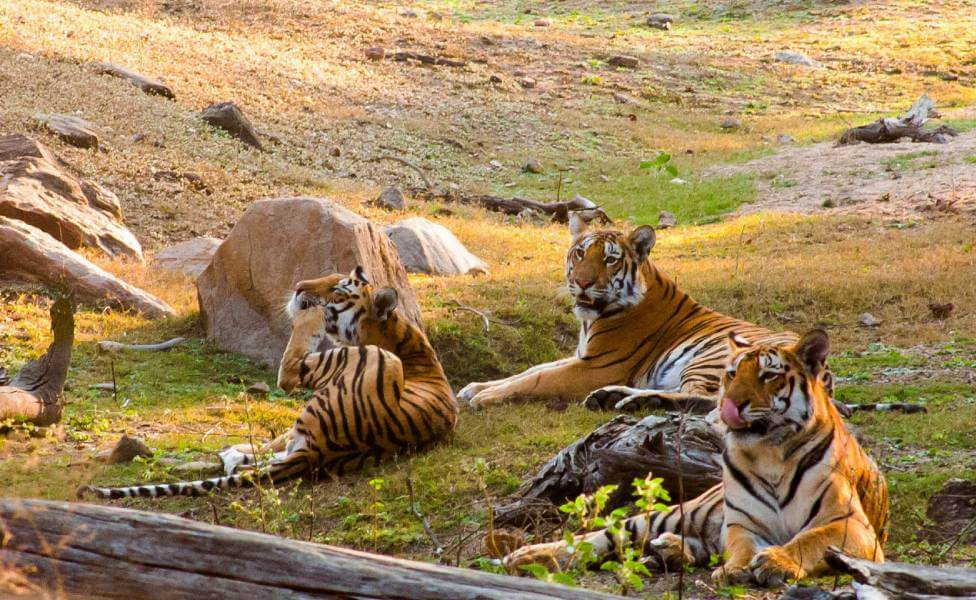
Named after the Pench River that flows through it, the Pench Tiger Reserve is located in Maharashtra and Madhya Pradesh and is among the best places in India to spot tigers. Situated in the Nagpur district of Maharashtra, the tiger reserve is the 25th one to be included as a tiger reserve under Project Tiger. According to the most recent report from the NTCA, the reserve is home to about 77 tigers in total. In addition to Bengal tigers, other wildlife found there includes leopards, Indian bison, Indian civets, and a sizable population of different antelope and deer species, including chinkara, sambhar, chinkara, chital, and barking deer.
Pench Tiger Reserve is also home to a number of bird species, both domestic and migratory in nature that will surely be a treat for the birdwatchers especially during the months of November to March when they migrate to less colder regions of the world. While at the reserve, you can opt for either a jungle walks or a safari to better explore the area. With the help of trained and experienced guides, you can also choose to explore Pench with a small trek, and travel through the rural settlements located on your way.
Pench is a mixture of Southern dry broadleaf teak forests and tropical mixed deciduous forests, Shrubs, climbers. Such vegetation is essential for the survival of many herbivores in the reserve, an abundance of which exist in Pench. Just like Kanha Tiger Reserve, the Pench Tiger Reserve is also considered to be the inspiration for Rudyard Kipling’s Jungle Book, the imaginary forests of Sal trees, creepers and climbers, which helped Mowgli run along, came to life due to the forests of Pench.
Even with 54 tiger reserves in the country, Pench Tiger Reserve has made itself into the top 12 when it comes to a healthy population of the Bengal Tigers. Being located close to each other, the Pench Tiger Reserve is connected to the Kanha Tiger Reserve through a corridor along the districts of Seoni, Balaghat, and Mandla.
The Pench Tiger Reserve in Maharashtra received a score of 90.91 percent, which is considered “excellent” for its efficient management of the reserve area by the NTCA and the Wildlife Institute of India (WII) during their Management Effectiveness Evaluation (MEE)- 2022, the final report regarding which was published by the NTCA on July 29, 2023 on the occasion of Global Tiger Day.
Timings for Jungle Safari at Pench (Maharashtra)
| Dates |
Morning Safari |
Evening Safari |
| 1st July to 30th Nov |
06.30 AM – 11.00 AM |
02.30 PM – 06.00 PM |
| 1st Dec to 28th/29th Feb |
06.30 AM – 10.00 AM |
02.00 PM – 06.00 PM |
| 1st March to 30th April |
05.30 AM – 09.30 AM |
03.00 PM – 07.00 PM |
| 1st May to 30th June |
05.30 AM – 09.30 AM |
03.00 PM – 07.00 PM |
Timings for Jungle Safari at Pench (Madhya Pradesh)
| Dates |
Morning Safari |
Evening Safari |
| October to June |
06.00 AM – 11.00 AM |
03.00 PM – 06.00 PM |
Note: Every year, Pench National Park and Reserve in Madhya Pradesh is closed to tourists from June 16 to September 30. Despite this, people can visit Pench National Park in Maharashtra year-round without any restrictions.
The land of the Royal Bengal Tigers, India loves its big cat. The country saw the state of its tigers in the 1970s and chose to do better. Fifty years since the advent of the Project Tiger, we do see a visible change in the population of the species, with only better reforms to come in the future. Even though they are still endangered, efforts on the part of the authorities and people have shown positive results. With 54 reserve forests declared as tiger reserves in India, the tigers have been thriving so far. If you wish to explore these forests and spot the tiger up close, opt for a jungle safari at any of these reserves that we listed out for you, and go on to live an adventure worth remembering.
Other Important Links
About the author
Sharon is a curious human who is always eager to learn about the history and mysteries of places, which she then brings to life with her words. A travel writer at Tour My India, her bucket list keeps expanding every day in search of places to explore.

 +91-9212777225
+91-9212777225 Plan Your trip
Plan Your trip